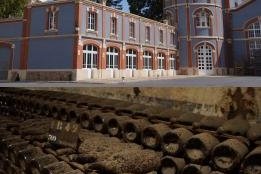
The Champagne WHS consists of three elements: the vineyards around Hautvillers and Ay, the architecture of the Champagne houses in Epernay and on the Saint-Nicaise Hill in Reims, and the network of chalk cellars in the subsoil of these sites.
We started exploring this WHS in Epernay. We left our car in a large parking lot in the town centre near the western end of the Avenue de Champagne. The Avenue de Champagne is about 1.5 kilometres long, the Champagne Houses are lined up next to each other on both sides of the street. Well, "Houses" is clearly an understatement, the terms chateaux or mansions are more applicable. Most of them were built in the 19th century. The Moet & Chandon company has the largest building and it is also the best known brand, most of the other names I had never heard before. Several of the Champagne Houses offer guided tours to the cellars, Le Castellane (easy to find because of the striking water tower) can be visited without pre-booking.
Next, we headed to the villages and vineyards north of Epernay. Hautvillers is the most picturesque village and is regarded as the birthplace of Champagner. The Benedictine monk Dom Perignon was in the 17th century the cellarer of the Abbey of St Peter. He significantly contributed to the development of the Méthode champenoise, the second fermentation in bottles, and the blending of different grape varieties. And a legend says that he also introduced the bottle size of 0.7 liters, because it's the average consumption of male adults at dinner! Today a statue honours the famous monk and his grave slab can be seen in the church of the former abbey.
In Ay, we went for a short hike in the hills. The vineyards were marked with white boundary stones, Moet & Chandon was the most frequent label. It was a nice hike in the lush green vineyards, the grapes were almost ripe in September. However, vineyards look more or less the same everywhere, nothing special even in the Champagne.
The highlights of our visit were the cellar tours at Pommery and Taittinger in Reims. The Saint-Nicaise Hill is located at the outskirts of Reims, the area is different from Epernay, the residences and production facilities are surrounded by vineyards and parks. Pommery has a really representative headquarters. I'm still unsure whether it is fine neo-gothic architecture, or rather a corny Disney-like fairy tale castle (upper photo shows a part). In any case, it is an imposing complex and is highly representative of the product: luxurious and high quality, but also a bit overdone. The tour starts with seemingly endless stairs, more than hundred steps lead directly down to the chalk cellars. The oldest galleries originate from former quarries from the Gallo-Roman period and have been extended to a total length of 18 kilometres, only at Pommery. The galleries even have street signs and were named after big cities. The tour also leads to some of the huge "crayères", funnel-shaped caves up to 60 metres high. It was very interesting and entertaining, the history of the company and the production process were explained in detail. We saw endless rows of Champagne bottles on old wooden racks or stacked to high walls of glass, all thickly coated in dust. We also saw the treasury: selected bottles from the best vintages. Everything very traditional. Unfortunately, the modern production facilities were not part of the guided tour, that would have been very interesting as well. We paid 24 euro per person for the tour with two tastings (18 euro for one tasting).
The next day we visited the Taittinger caves because they are said to be the most beautiful. However, there were no significant differences between the two, neither in content and quality of the guided tour, nor in the price. Maybe the caves (crayères) are not as high as those at Pommery, but you can see the remains of the abbey, a few steps and doors. So, one cave visit would be enough if you have no special interest in the tasting. The advantage with Taittinger is that you can visit without prior reservation. But one cave tour is a must to properly visit this WHS.
The Champagne WHS is a combination of an agricultural landscape, a traditional production procedure that is used until today, and typical architecture. Thus, I would say that the inscription in 2015 was justified, although vineyards were already well represented. And even though I prefer non-sparkling wine.
Comments
No comments yet.
